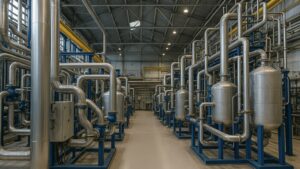The growth of energy costs coupled with the need to cut GHG emissions force companies to find every available tool to limit energy use. While there have been advancements in more sustainable equipment, managers are still forced to oversee massive, interconnected facilities. Food and beverage operations are complex and a human can at times struggle with the sheer quantities of data. Recent developments in AI may be the answer, with some innovations capable of cutting 25% of energy costs. Computers and machines are able to view and synthesize insights out of datasets too large for humans. So how can a company employ artificial intelligence to direct its energy strategy?
AI in metering
Any energy management system must rely on accurate, regular data inputs. All facilities must collect data from energy consumption points. Armed with this information, managers can understand when and where facilities use energy, be it power, water, steam, or gas. The food and beverage industry in particular can struggle with understanding how their facilities use energy. Since the industry has more in-depth humidity, light, and heat needs, HVAC systems, for example, will work very differently. Since, heating, light, and humidity all vary from season to season and in different weather conditions, longitudinal data is important. AI solutions can be used to gather relevant data and pinpoint energy-saving solutions. Qualitative research on the effectiveness of AI in facility energy management has been positive. For example, AI-assisted HVAC control can reduce chase time while still providing the necessary climate inputs. A 2021 study found that existing systems could already achieve nearly 25% savings for HVAC. Similar BEMS systems had even better performance, with approximately 35% increased efficiency.
Automation for control
AI has uses outside of just data management. Certain tools can even be integrated into the day-to-day operations of a facility. For example, an energy management system (EMS) can process the energy use of all facility machinery simultaneously. It can calculate what rate certain machinery should work at and adjust it to output needs. An EMS can also manage the facilities grid. Should a generating station disconnect, it can select the most energy-efficient way to reintroduce power. Imagine an operator using a higher-energy setting on a machine for a one-time event. Furthermore, if the operator does not revert the setting, the machine could be using more energy than necessary in all subsequent shifts. An automated system could quickly locate and rectify this human error. In general, AI systems have the advantage of not requiring equipment overhauls. Existing machinery can simply be used in the mathematically most efficient way by an always vigilant computer.
AI for prediction
AI does not just work with existing data, it has the potential to create predictive models about future energy use. In a Danish wastewater treatment plant, AI-guided control algorithms were effective at reducing GHG emissions. Simulatainiusly, the predictive model helped cut operation costs, compared to the previously used control method. Other algorithms could also help a company forecast future energy prices. Fed regular data from smart meters, together with the massive amounts of energy price figures, an AI can extrapolate future price variants. Existing AI tools have the ability to create models of a building or facility. The system will develop a plan for the next 24 hours based on a variety of data. For example, it can read environmental data about weather forecasts. Knowing that the next day is likely to be warmer, it can limit the amount of heating earlier to save energy. Similarly, neural networks can also help forecast when machines and infrastructure might need maintenance. Preventative maintenance has cumulative advantages. Companies can stock spare parts, plan the best times to actually perform maintenance, and avoid catastrophic failures.
What should companies do?
Companies that do not have an energy management plan for the future risk unpredictable costs and regulatory attention. GHG reduction laws mean that businesses need to understand how to limit all their emissions. Energy is a big carbon emitter, hence it has its own Scope (2) that companies must report on. There is also a reputational risk for not limiting emissions. Greenwashing legislation is expanding around the world and is likely to become more established. Overall, energy efficiency has gained importance past simple monetary savings. AI gives businesses the opportunity to limit energy use without overhauls of equipment and reduced output. Companies need to learn from their peers who have embraced this technology. The Net Zero Food & Beverage Forum: Energy Efficiency and Decarbonisation conference, held from the 16th to 17th of February is an ideal opportunity. Industry leaders and innovators will gather in Berlin to discuss and exchange ideas and experiences with managing energy consumption. Visit future-bridge.eu or follow us on our social media to track other energy use and decarbonization events.





